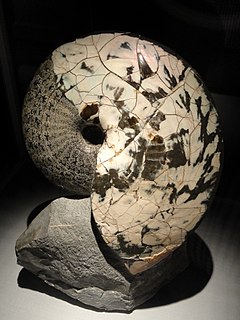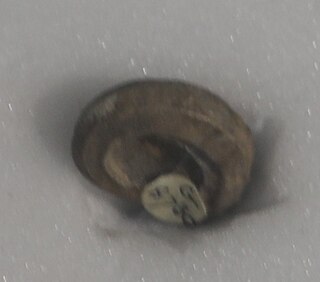 W
WActinoceramus is an extinct genus of fossil saltwater clams, marine pteriomorphian bivalve molluscs. These bivalves were facultatively mobile infaunal suspension feeders.
 W
WAnatosuchus is an extinct genus of notosuchian crocodylomorph discovered in Gadoufaoua, Niger, and described by a team of palaeontologists led by the American Paul Sereno in 2003, in the Journal of Vertebrate Paleontology. Its duck-like snout coincidentally makes it resemble a crocoduck, an imagined hybrid animal with the head of a crocodile and the body of a duck.
 W
WAncyloceras is an extinct genus of heteromorph ammonites found throughout the world during the Lower Cretaceous, from the Lower Barremian epoch until the genus extinction during the Lower Aptian.
 W
WAustraliceras is an extinct ammonite genus from the upper part of the Early Cretaceous, Aptian stage, included in the family Ancyloceratidae.
 W
WCymatoceras is a wide-ranging extinct genus from the nautilitacean cephalopod family, Cymatoceratidae. They lived from the Late Jurassic to Late Oligocene, roughly from 155 to 23 Ma.
 W
WHerrickiceras is an ammonite from the Upper Cretaceous which belongs to the Coilopoceratidae, a family within the superfamily Acanthoceratoidea. Herrickiceras has an established range in the Middle Turonian of the Upper Cretaceous. Its distribution is widespread, from western North America through Central Africa and the Middle East.
 W
WHeteraster is an extinct genus of sea urchins belonging to the family Toxasteridae.
 W
WHippurites is an extinct genus of bivalve mollusc in the rudist family, from the Late Cretaceous of Africa, Asia, Europe, North America, and South America.
 W
WIsastrea is an extinct genus of corals that lived during the Jurassic and Cretaceous periods. Its fossils have been found in Europe, Africa, North America, Asia and South America.
 W
WMacroscaphites is an extinct cephalopod genus included in the Ammonoidea that lived during the Barremian and Aptian stages of the Early Cretaceous. Its fossils have been found throughout most of Europe and North Africa.
 W
WMortoniceras is an ammonoid genus belonging to the superfamily Acanthocerataceae, named by Meek in 1876, based on Ammonites vespertinu, named by Morton in 1834.
 W
WPuzosia (Bhimaites) is a subgenus of desmoceratid ammonites with a subinvolute, mostly smooth, high whorled shell with convex or flat sides and frequent constrictions on the venter. It is included in the subfamily Puzosiinae and has been found in Upper Albian and Cenomanian sediments in Angola, South Africa, and southern India.
 W
WRotularia is an extinct genus of planispirally coiled fossil polychaete worms in the family Serpulidae. Owing to the gastropod-like shape of Rotularia, many authors in the past interpreted this genus as being sea snails in the family Vermetidae.